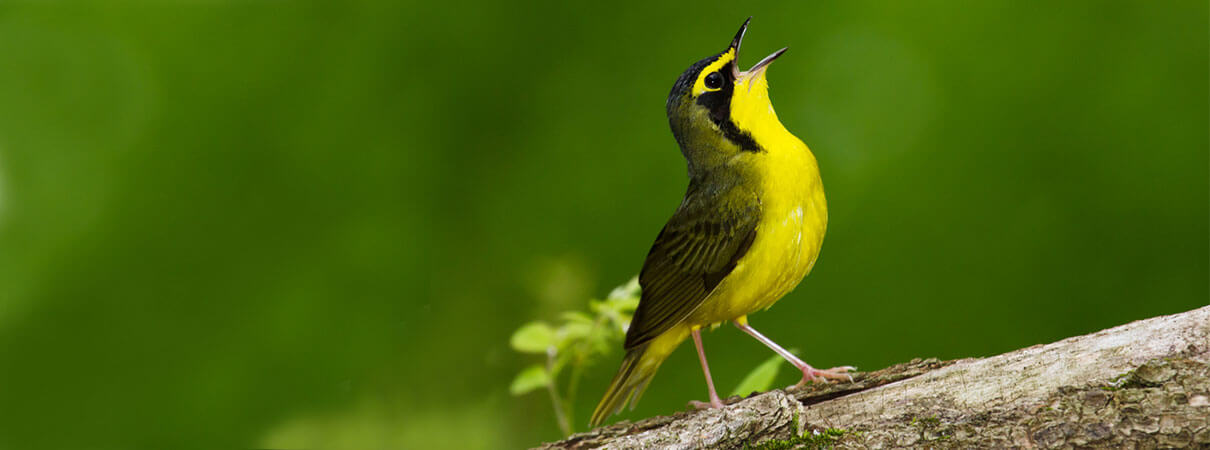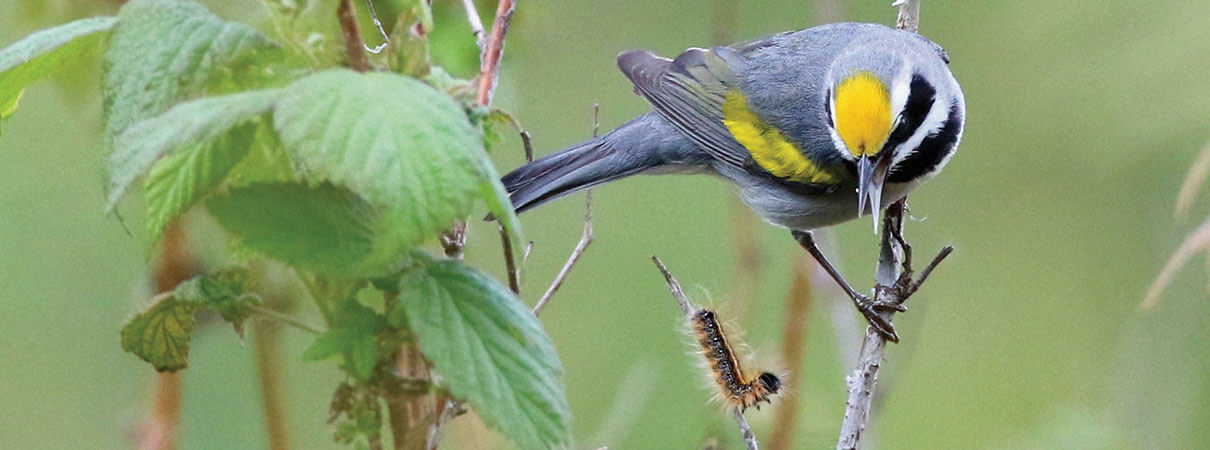Are Caterpillars Part of the Cure for Ailing Cerulean Warblers?
Birds, like all animals, depend on a healthy environment for food. But as humans alter the natural landscape, traditional food and feeding dynamics have changed, creating new challenges for vulnerable bird populations. To help these birds, ABC partners with government agencies, other conservation groups, private landowners, and industry representatives to ensure carefully managed habitats — and thus food supplies — are available.
Much of this habitat work is supported by funding from the Natural Resources Conservation Service (NRCS) Regional Conservation Partnership Program (RCPP), which promotes coordination of NRCS conservation activities with partners who can expand the program's ability to address on-farm, watershed, and regional natural resource concerns.
In this, the first of our three-part series on efforts to increase natural food sources for birds, we look at how conservationists and foresters in Appalachia and beyond are helping Cerulean Warblers and other birds rebound by restoring a primary source of sustenance: caterpillars.
Caterpillar-rich Forests: A Feast for Warblers
In a stand of trees on a snow-dusted western Maryland ridgetop, Amanda Duren is talking about bird food. But it's not the relative merits of suet or sunflower seeds she's discussing on this bracingly cold January day — it's caterpillars.
“Caterpillars are a hugely important food source for Cerulean Warblers,” says Duren, ABC's Appalachian Mountains Joint Venture (AMJV) Habitat Delivery Coordinator. Duren is referring to the sky-blue-backed songbirds that return in spring to breed in Appalachian forests around here. “Nestlings need protein to grow, and caterpillars are one of the best sources of protein. They make up more than half the food brought to the nest.”
Duren stands next to Shannon Farrell, a private lands forester with the U.S. Department of Agriculture's Natural Resources Conservation Service (NRCS) and Indiana University of Pennsylvania. They are both here to check out a project on private land that will help bolster caterpillar populations for the declining warbler and other insectivorous forest birds, including the Kentucky Warbler, Scarlet Tanager, and Yellow-billed Cuckoo. Their goal: To work with the landowner to restore insect-rich oak and hickory forests that once dominated sites like this.

Cerulean Warbler. Photo by Ray Hennessy/Shutterstock
“Caterpillars have evolved alongside our native plants so that they can only eat a certain subset of host plants,” says Duren, “and White Oaks host more caterpillars than any other species of tree. Hickory is really high up there as well. From a bird-food perspective, we want to encourage this shift back to an oak-hickory-dominated forest.”
Birds Away, Chainsaws at Play
Spring seems like a distant dream on the frozen, windswept ridgetop. In fact, the warblers Duren, Farrell, and their colleagues aim to help are wintering far away in northern South America, plucking caterpillars from glossy leaves in forested foothills of the Andes.
While the birds are away, chainsaws are at play. A logging crew has nearly finished loading a long, staked truck trailer with 12-foot logs, ready to take to the nearby paper mill. Branches, brush, and sawdust litter the ground, presided over by a stand of remaining oaks, which reach into the cold blue sky.
How will tree-cutting help this forest grow? “It seems counter-intuitive to use tree harvests to create old-growth forest conditions, but that's what we're doing,” says Duren. “We're basically re-creating natural disturbances like wildfires, windstorms, and gaps caused by falling trees. We're doing what Mother Nature would have done over 200 years, but we're doing it faster.” The crew has removed maple and birch trees, opening up the forest canopy to make room for oak and hickory seedlings, which need sunlight to grow.

Kentucky Warbler. Photo by Frode Jacobsen
This Cerulean Warbler conservation work is part of the Cerulean Warbler Appalachian Forestland Enhancement Project. In 2015, the AMJV initiated this 5-year project, funded through the Natural Resources Conservation Service (NRCS) Regional Conservation Partnership Program (RCPP). This project dedicated $8 million of federal funds to Cerulean Warbler conservation efforts on private lands. Over 20 AMJV partners, primarily state agencies and nonprofit groups like the National Wild Turkey Federation and ABC, are assisting with this project, contributing an additional $8 million in direct and in-kind support. In Maryland, this work is a collaborative effort among the AMJV and ABC, Maryland's Department of Natural Resources, Maryland Natural Resources Conservation Service, Indiana University of Pennsylvania, and the Allegany Soil Conservation District, working with the landowner and a local paper company's logging crew.
The aftermath of the morning's work might not look pretty, but soon — perhaps within a few growing seasons — this tract will host a healthier population of caterpillars, and hopefully nesting and foraging sites for birds currently wintering 2,000 miles south of here.

Golden-winged Warbler. Photo by Gene Koziara
Leafy Trees and Sun-dappled Openings
Cerulean Warblers prefer to nest in large tracts of mature forest, both in uplands and along river valleys and stream courses. These habitats must have a mix of tall, leafy trees and sun-dappled openings in the canopy, helping the birds hide their cup-shaped nests, while providing plenty of food.
Unfortunately, history has not been kind to the type of forests Ceruleans favor. Most old-growth Appalachian forests were cut more than two centuries ago, Farrell explains. Then, much of the cleared land was tilled and turned to pasture or row crops. Some forests re-grew, but landowners doused wildfires that formerly created forest gaps, cut the large oaks and other commercially valuable trees, and unwittingly or intentionally introduced invasive exotic plants, animals, and diseases, many of which spread rapidly, including devastating chestnut blight.
Generations of these practices — along with other challenges such as the deer population explosion and, likely, climate change — resulted in a dramatic shift in the composition of remaining Appalachian forests.
Losing both mature forests in the East and Andean wintering habitat to the south, the Cerulean Warbler population dropped by about 70 percent over the past 50 years. The International Union for the Conservation of Nature (IUCN) now lists the species as Vulnerable, while the U.S. Fish and Wildlife Service (USFWS) considers it a Species of Concern.

Scarlet Tanager. Photo by FotoRequest/Shutterstock
Beyond Caterpillars: Acorns and Greenbacks
In the Appalachians and in the Central Hardwoods region, ABC and its Joint Venture partners aim to improve Cerulean Warbler habitat. Strategies vary by site. In some places, fencing keeps deer from mowing down precious hardwood seedlings. At other sites, herbicide applications may be necessary to keep invasive plants like nonnative honeysuckles and Autumn Olive from taking over the forest. And, over time, former surface mines are being transformed from something like a moonscape back into forest.
At some of the same restoration sites, another declining warbler benefits from boosted food supplies, only far sooner. The Golden-winged Warbler overlaps with the Cerulean in much of its breeding range, but nests in brush-and-thicket early successional habitats. There, too, robust insect populations are key. “I had one landowner say, ‘Oh, you're not managing for warblers, you're managing for caterpillars.' And he was 100 percent correct,” says ABC's Golden-winged Warbler Private Lands Coordinator Kevin Sheppard. Sheppard works with private landowners in northern Minnesota, a state that provides breeding grounds for roughly half of the remaining Golden-winged Warbler population.
There are additional benefits to this forest restoration work. Back in the Maryland forest, the collaborative effort will not only produce more caterpillars for birds — the growing oaks will also provide acorns, an important protein-rich food source for more than 100 other wildlife species, including Wild Turkeys and Black Bears. And the sustainably cut trees will provide a valuable crop of greenbacks for the landowner, who will get paid for the logs, but also will receive a cost-share payment from NRCS to compensate for the value of the trees left behind.
“There are so many benefits to doing this type of management,” says Duren. “The landowner sees benefits, we see benefits not just for birds but all kinds of wildlife, and then the local economic impact of having this paper company sourcing its wood locally in a way that's sustainable is really important, too.”
Want to learn more about ABC's efforts to help nature feed birds? Check out A Banquet For Birds: Conservationists Boost Prairie Birds' Invertebrate Intake and Seafood For Seabirds: Puffins And Other Birds Depend On Human Restraint the second and third installments in our three-part series on boosting bird diets.
 | Mark Cheater is a writer, editor, and photographer who lives in Greenbelt, Maryland. |


















































